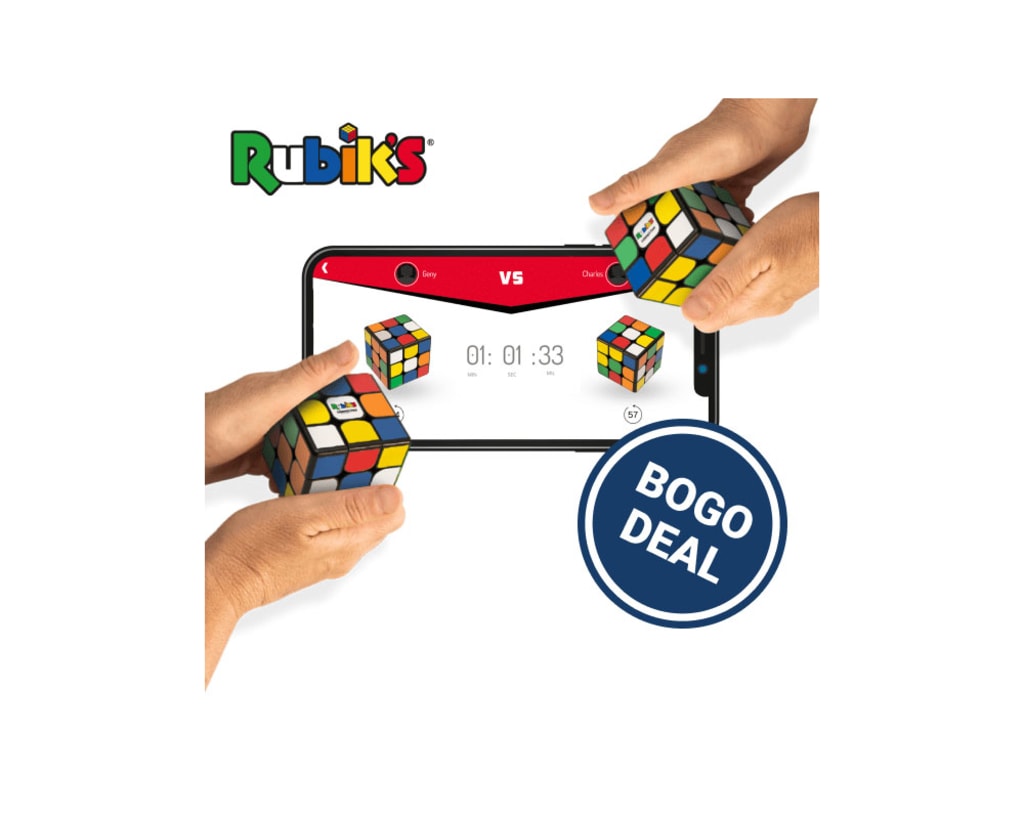The Rubik’s Cube Decoded: Using simple formula to beat it all the way!
Understanding the cube’s structure and notation system

Rubik's Cube Decoded: Using simple formula to beat it all the way!
Are you looking to learn a Cube formula and algorithm? Well, look no further! The perplexing puzzle that has captivated the world since its invention in 1974. It can be difficult to understand the basics, let alone solve it. But with the right formula and algorithm, you'll be able to master the cube with ease. This blog post will explain exactly how to use a simple formula. Decoded Formula.
Brief history and popularity
A mind-boggling puzzle burst onto the scene in 1974 and quickly gained worldwide popularity. Created by Hungarian architect Erno Rubik, this captivating toy has captured the imagination of millions. Originally known as the "Magic Cube," Rubik's invention was initially intended to help students understand three-dimensional geometry. Little did he know that his creation would become a global sensation. It has achieved cult status over the years, appearing in movies, art installations, and even competitions. It has become an iconic symbol of problem-solving and logical thinking.
Today, it has transcended its humble origins and found its place in popular culture. It has inspired numerous books, apps, and even an AI-powered robot that can solve the cube in record time. With its colourful design and seemingly endless possibilities, it continues to intrigue and challenge enthusiasts of all ages. Whether you're a beginner or an expert, it offers an exciting mental workout and endless hours of fun.
Understanding the structure and notation system
It may seem like a daunting puzzle at first, but once you understand its structure and notation system, you'll be well on your way to solving it with ease. Let's dive into the inner workings of the cube and how to interpret the notations. It consists of a 3x3 grid of small cubes, also known as cubies. These cubies are attached to an internal framework, allowing them to rotate freely. Each face of the cube is made up of nine cubies, with a total of six faces in different colours.
To understand the notation system, you need to familiarize yourself with the six faces of the cube. The front face is represented by F, the back face by B, the right face by R, the left face by L, the top face by U, and the bottom face by D. By using these letters along with specific symbols such as ', 2, and lowercase letters, you can indicate different moves and rotations of the cube.
Basic solving strategies
Now that you have a grasp on the structure and notation, it is time to dive into the basic strategies for solving the cube. These strategies will serve as a solid foundation for your solving journey, whether you're a beginner or looking to improve your solving skills. One of the most popular and beginner-friendly methods for solving is the Layer-By-Layer method. This method involves solving one layer at a time, starting with the first layer, then the second, and finally the last layer. By breaking down the cube into smaller, more manageable steps, you can gradually build your solving skills.
Another essential strategy is learning different algorithms or sequences of moves that can manipulate the cube's pieces. These algorithms are like formulas that, when executed in the correct order, can solve specific patterns or situations on the cube. By memorizing and practicing these algorithms, you'll be able to tackle different scenarios and solve the cube more efficiently. To aid you in your solving journey, there are numerous resources available, such as books, apps, and online tutorials. These resources provide step-by-step instructions, visual guides, and even interactive tools to help you understand and practice solving the cube.
Introducing the CFOP method
If you've already mastered the basic strategies for solving the cube and you're ready to take your skills to the next level, then the CFOP method is for you! CFOP, which stands for Cross, F2L, OLL, and PLL, is an advanced solving method that is widely used by speedcubers around the world. The CFOP method was popularized by Jessica Fridrich, a Czech speedcuber and mathematician. This method involves breaking down the solving process into four distinct steps, each focusing on a different aspect of the cube. By mastering each step and implementing specific algorithms, you'll be able to solve the cube faster and more efficiently than ever before.
The first step in the CFOP method is the Cross, where you solve a cross on one face of the cube. Next, you move on to the F2L (First Two Layers) step, where you solve the first two layers of the cube while pairing up the corner and edge pieces. The third step is the OLL (Orientation of the Last Layer), where you orient all the pieces on the last layer. Finally, the fourth step is the PLL (Permutation of the Last Layer), where you permute the pieces on the last layer to solve the cube completely.
The CFOP method requires some memorization of algorithms, but don't worry, there are plenty of resources available to help you learn and practice. You can find algorithms in books, online tutorials, and even apps dedicated to solving. With time and practice, you'll be able to execute the CFOP method with speed and precision, impressing your friends.
Walkthrough of each step in the CFOP method
Now that you're familiar with the CFOP method, let's dive into a step-by-step walkthrough of each stage in this advanced solving technique. This walkthrough will guide you through the process of solving using CFOP, ensuring that you have a clear understanding of each step and the corresponding algorithms.
- Step 1: Cross - Begin by solving a cross on one face of the cube. This involves strategically placing and orienting the edge pieces to form a cross shape. You can use the F2L technique to insert the corner pieces while solving the cross. Remember to reference the notation system and the algorithms you've learned to make the necessary moves.
- Step 2: F2L (First Two Layers) In this step, you'll solve the first two layers of the cube while pairing up the corner and edge pieces. This requires careful observation and planning to ensure that you're correctly aligning and inserting the pieces. Be sure to practice the F2L algorithms to become comfortable with the moves involved.
- Step 3: OLL (Orientation of the Last Layer) Once the first two layers are complete, it's time to orient all the pieces on the last layer. This step involves manipulating the cube's pieces to align them correctly, allowing for easier completion in the final step. Make use of the OLL algorithms to efficiently orient the last layer.
- Step 4: PLL (Permutation of the Last Layer) The final step is to permute the pieces on the last layer, ensuring that all the colours are aligned, and the cube is completely solved.
By executing the PLL algorithms, you'll be able to swap and position the pieces accurately, bringing you one step closer to victory. Remember, practice is key to mastering the CFOP method. Be patient and dedicated in your pursuit of solving this advanced technique. With time and perseverance, you'll become a pro solver in no time.
Tips and tricks for faster solving
Ready to take your solving skills to the next level? Here are some tips and tricks that will help you solve the cube faster and more efficiently.
- 1. Practice, practice, practice: The key to getting faster at solving is to practice regularly. Set aside dedicated practice sessions and challenge yourself to beat your personal best time.
- 2. Memorize algorithms: To solve the cube quickly, it's essential to memorize algorithms for different patterns and situations. There are many resources available, such as books and apps, that provide algorithm sheets and guides.
- 3. Look ahead: As you become more experienced, start looking ahead while solving. Try to anticipate your next moves to save time and avoid unnecessary pauses.
- 4. Finger tricks: Learn finger tricks to execute moves quickly and efficiently. Experiment with different finger placements and find what works best for you. Smooth, fluid motions will help you solve the cube faster.
- 5. Develop a solving method: As you gain more experience, you may find that certain steps of the solving process are more efficient for you. Customize your solving method by incorporating your own algorithms and techniques.
- 6. Join a competition: Participating in competitions can provide motivation and opportunities to learn from others. These events offer a chance to showcase your skills and improve your solving time.
Troubleshooting common mistakes and setbacks
So, you've been working hard to solve, but you're encountering some roadblocks along the way. Don't worry, we've got you covered! In this section, we'll address some common mistakes and setbacks that beginner and intermediate solvers often face. By identifying and addressing these issues, you'll be well on your way to conquering the cube. One common mistake is getting stuck in a never-ending cycle of moves. This can happen when you don't have a clear plan or strategy in mind and start making random moves. To avoid this, always have a goal in mind for each step and think several moves ahead.
By planning your moves, you'll be able to avoid getting stuck and wasting time. Another setback that many solvers encounter is scrambling the cube incorrectly. This can lead to a jumbled mess that seems impossible to solve. To prevent this, always start with a well-scrambled cube by mixing up the colours thoroughly. If you're unsure how to scramble the cube properly, there are resources available, such as apps and online tutorials, that can provide guidance.
A common mistake that beginners make is not properly aligning the pieces during the solving process. This can result in mismatched colours and an unsolved cube. To avoid this, pay close attention to the position and orientation of each piece as you solve. Take your time and double-check your work to ensure that everything is aligned correctly. Another common setback is forgetting algorithms or executing them incorrectly. Algorithms are like formulas that guide your moves to solve specific patterns or situations on the cube. If you're having trouble remembering or executing algorithms, take the time to practice them regularly.
Finally, don't be discouraged by setbacks or slow progress. Solving the is a challenging task that requires practice and patience. Celebrate the small victories along the way and remember that every mistake or setback is an opportunity to learn and improve. With time and dedication, you'll be able to overcome any challenge and become a master.
Advanced methods for speed cubing enthusiasts
For those speed cubing enthusiasts looking to take their solving skills to the next level, there are several advanced methods and techniques that can elevate your solving game. These methods are designed to help you solve the cube faster and more efficiently, perfect for those who are looking to improve their speed cubing abilities.
One advanced method that many utilize is the Roux Method. Developed by French Gilles Roux, this method focuses on solving the cube in fewer moves and with less finger movement. The Roux Method requires a deep understanding of cube structure and a good sense of spatial awareness.
Another advanced method is the ZZ Method, which stands for "Zbigniew Zborowski. " This method is known for its efficiency and its ability to solve the cube with fewer algorithms compared to other methods. It focuses on solving the cube in three steps, first building a 2x2x3 block, then orienting the remaining pieces, and finally permuting them to complete the cube. The ZZ Method requires careful planning and an understanding of advanced cube algorithms.
There are also various other advanced methods and techniques used by many such as the Petrus Method, the Heise Method, and the Waterman Method. Each of these methods offers its own unique approach to solving and requires dedication, practice, and a deep understanding of cube algorithms. To improve your speed cubing abilities, it's essential to continue practicing and experimenting with different methods.
About the Creator
Ester Lenizo
Travel Organizer, Trip Planner, Sports Coordinator, Freelance Blogger.






Comments
There are no comments for this story
Be the first to respond and start the conversation.